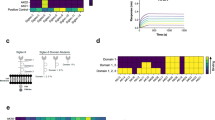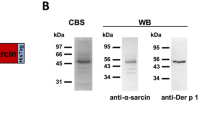Abstract
Human mast cells and basophils that express the high-affinity immunoglobulin E (IgE) receptor, Fcɛ receptor 1 (FcɛRI), have key roles in allergic diseases. FcɛRI cross-linking stimulates the release of allergic mediators1. Mast cells and basophils co-express FcγRIIb, a low affinity receptor containing an immunoreceptor tyrosine-based inhibitory motif and whose co-aggregation with FcɛRI can block FcɛRI-mediated reactivity2,3,4. Here we designed, expressed and tested the human basophil and mast-cell inhibitory function of a novel chimeric fusion protein, whose structure is γHinge-CHγ2-CHγ3-15aa linker-CHɛ2-CHɛ3-CHɛ4. This Fcγ–Fcɛ fusion protein was expressed as the predicted 140-κD dimer that reacted with anti-human ɛ- and γ-chain specific antibodies. Fcγ–Fcɛ bound to both human FcɛRI and FcγRII. It also showed dose- and time-dependent inhibition of antigen-driven IgE-mediated histamine release from fresh human basophils sensitized with IgE directed against NIP (4-hydroxy-3-iodo-5-nitrophenylacetyl). This was associated with altered Syk signaling. The fusion protein also showed increased inhibition of human anti-NP (4-hydroxy-3-nitrophenylacetyl) and anti-dansyl IgE-mediated passive cutaneous anaphylaxis in transgenic mice expressing human FcɛRIα. Our results show that this chimeric protein is able to form complexes with both FcɛRI and FcγRII, and inhibit mast-cell and basophil function. This approach, using a Fcγ–Fcɛ fusion protein to co-aggregate FcɛRI with a receptor containing an immunoreceptor tyrosine-based inhibition motif, has therapeutic potential in IgE- and FcɛRI-mediated diseases.
This is a preview of subscription content, access via your institution
Access options
Subscribe to this journal
Receive 12 print issues and online access
$209.00 per year
only $17.42 per issue
Buy this article
- Purchase on Springer Link
- Instant access to full article PDF
Prices may be subject to local taxes which are calculated during checkout



Similar content being viewed by others
References
Ott, V.L. & Cambier, J.C. Activating and inhibitory signaling in mast cells: New opportunities for therapeutic intervention? J. Allergy Clin. Immunol. 106, 429–440 (2000).
Ravetch, J.V. Fc receptors. Curr. Opin. Immunol. 9, 121–125 (1997).
Daeron, M. et al. The same tyrosine-based inhibition motif, in the intracytoplasmic domain of FcγRIIB, regulates negatively BCR-, TCR-, and FcR-dependent cell activation. Immunity 3, 635–646 (1995).
Daeron, M., Malbec, O., Latour, S., Arock, M. & Fridman, W.H. Regulation of high-affinity IgE receptor-mediated mast cell activation by murine low-affinity IgG receptors. J. Clin. Invest. 95, 577–585 (1995).
Oliver, J.M., Kepley, C.L., Ortega, E. & Wilson, B.S. Immunogically mediated signaling in basophils and mast cells: Finding therapeutic targets for allergic diseases in the human FcɛRI signaling pathway. Immunopharmacology 48, 269–281 (2000).
Daeron, M. Fc receptor biology. Annu. Rev. Immunol. 15, 203–234 (1997).
Daeron, M. Building up the family of ITIM-bearing negative co-receptors. Immunol. Lett. 54, 73–76 (1996).
Ono, M., Bolland, S., Tempst, P. & Ravetch, J.V. Role of the inositol phosphatase SHIP in negative regulation of the immune system by the receptor FcγRIIB. Nature 383, 263–266 (1996).
Fong, D.C. et al. Selective in vivo recruitment of the phosphatidylinositol phosphatase SHIP by phosphorylated FcγR IIB during negative regulation of IgE-dependent mouse mast cell activation. Immunol. Lett. 54, 83–91 (1996).
Daeron, M. Negative regulation of mast cell activation by receptors for IgG. Int. Arch. Allergy Immunol. 113, 138–141 (1997).
Malbec, O. et al. Fcɛ Receptor I-associated lyn-dependent phosphorylation of Fcγ Receptor IIB during negative regulation of mast cell activation. J. Immunol. 160, 1647–1658 (1998).
Ravetch, J.V. & Lanier, L.L. Immune inhibitory receptors. Science 290, 84–89 (2000).
Takai, T., Ono, M., Hikida, M., Ohmori, H. & Ravetch, J.V. Augmented humoral and anaphylactic responses in FcγR II-deficient mice. Nature 379, 346–349 (1996).
Huston, J.S. et al. Protein engineering of antibody binding site: Recovery of specific activity in an anti-digoxin single-chain Fv analogue produced in Escherichia coli. Proc. Natl. Acad. Sci. USA 85, 5879–5883 (1988).
Helm, B. et al. The mast cell binding site on human immunoglobulin E. Nature 331, 180–183 (1988).
Hulett, M.D., Witort, E., Brinkworth, R.I., Mckenzie, I.F. & Hogarth, P.M. Identification of the IgG binding site of the human low affinity receptor for IgG Fc gamma RII. J. Biol. Chem. 269, 15287–15293 (1994).
Hendershot, L.M. & Kearney, J.F. A role for human heavy binding protein in the developmental regulation of immunoglobulin transport. Mol. Immunol. 25, 585–593 (1988).
Wedi, B., Lewrick, H., Butterfield, J.H. & Kapp, A. Human HMC-1 mast cells exclusively express the FcγR II subtype of IgG receptor. Arch. Dermatol. Res. 289, 21–27 (1996).
Kepley, C.L. et al. Negative regulation of FcɛRI signaling by FcγR II costimulation in human blood basophils. J. Allergy Clin. Immunol. 106, 337–348 (2000).
Dombrowicz, D. et al. Anaphylaxis mediated through a humanized high affinity IgE receptor. J. Immunol. 157, 1645–1651 (1996).
Fung-Leung, W.P. et al. Transgenic mice expressing the human high-affinity immunoglobulin (Ig) E receptor α chain respond to human IgE in mast cell degranulation and in allergic reactions. J. Exp. Med. 183, 49–56 (1996).
Acknowledgements
We thank S.L. Morrison and R. Trinh for technical assistance and providing some experimental materials. We also thank Jean-Pierre Kinet for providing the transgenic mice expressing the human FcɛRIα. We are grateful to M. Lipscomb and J. Oliver from the UNM Asthma SCOR programs. This study was supported by NIH grant (AI-15251) to A.S. C.L.K. was supported by an American Lung Association-funded UNM Asthma Research Center grant, an Interest Section grant from the AAAAI and a Fellowship from the Parker B. Francis Foundation.
Author information
Authors and Affiliations
Corresponding author
Ethics declarations
Competing interests
A.S., D.Z. and K.Z. are listed as inventors on the patent for the use of bifunctional proteins to block allergic reactions. This patent is held by the University of California, their employer.
Rights and permissions
About this article
Cite this article
Zhu, D., Kepley, C., Zhang, M. et al. A novel human immunoglobulin Fcγ–Fcɛ bifunctional fusion protein inhibits FcɛRI-mediated degranulation. Nat Med 8, 518–521 (2002). https://doi.org/10.1038/nm0502-518
Received:
Accepted:
Issue Date:
DOI: https://doi.org/10.1038/nm0502-518
This article is cited by
-
Allergic rhinitis, allergic contact dermatitis and disease comorbidity belong to separate entities with distinct composition of T-cell subsets, cytokines, immunoglobulins and autoantibodies
Allergy, Asthma & Clinical Immunology (2022)
-
Understanding human mast cells: lesson from therapies for allergic and non-allergic diseases
Nature Reviews Immunology (2022)
-
Ephedra Herb, Mao, Inhibits Antigen-Induced Mast Cell Degranulation by Induction of the Affinity Receptor for IgE Internalization
Pharmaceutical Research (2021)
-
Modified Allergens for Immunotherapy
Current Allergy and Asthma Reports (2018)
-
Potential effector and immunoregulatory functions of mast cells in mucosal immunity
Mucosal Immunology (2015)



